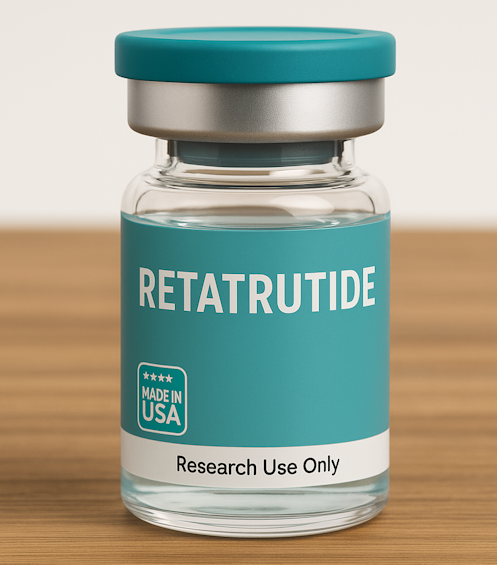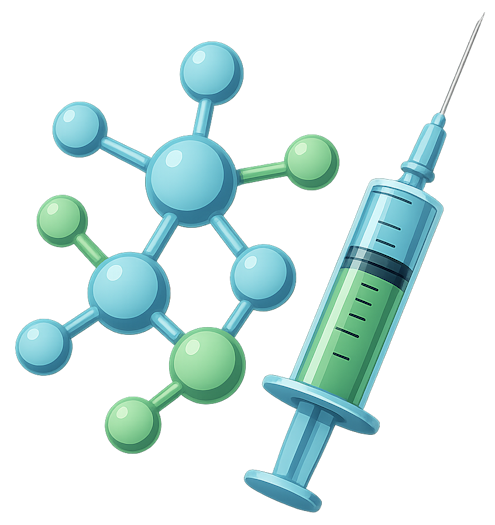Retatrutide is a cutting-edge peptide currently being studied for its role in weight management, glucose regulation, and as a multi-pathway receptor agonist affecting both GLP-1 and glucagon receptors. To learn more about availability and verified suppliers, you can buy Retatrutide peptide online from trusted research vendors. It is part of a new class of medication that has shown promising results in clinical trials for reducing body weight and improving metabolic health. According to recent findings published in the New England Journal of Medicine, this drug is considered one of the most advanced compounds in development for obesity treatment.
For researchers handling it in a lab setting, understanding how to reconstitute this peptide correctly is critical to maintaining peptide integrity, ensuring accurate dosing, and preventing contamination. This guide will provide guidance on the entire reconstitution process, from preparation to administering the reconstituted solution using safe and sterile techniques.
For a list of trusted suppliers, see our overview of Retatrutide for sale.
Understanding the Basics of Retatrutide Reconstitution

Retatrutide is supplied as a lyophilized powder stored in a sterile vial. Before it can be used for research, it must be reconstituted with bac water (short for bacteriostatic water). The addition of the proper solvent allows the powder to dissolve into a solution for precise subcutaneous injection.
The reconstitution process involves adding a specific solvent volume to achieve the desired concentration, which determines the final dosage in each injection. A correct calculation is necessary to accurately calculate how much bac water to add to the vial. This step is essential for researchers to prepare an accurate amount of this peptide for study purposes.
During this stage, it’s critical to protect the peptide from light, extreme temperature changes, and repeated freeze thaw cycles, as these factors can reduce stability and overall effectiveness. Improper handling can lead to partial breakdown of the peptide, compromising experimental results.
Step-by-Step Guide: How to Reconstitute It
The steps below provide guidance for safely handling and reconstituting this peptide in a laboratory environment.
1. Prepare your workspace
Ensure the area is clean and well-lit. Gather all required materials:
- Retatrutide vial containing the lyophilized powder
- Bac water
- Insulin syringe for measuring solvent volume and final doses
- Alcohol swabs to disinfect vial tops and reduce risk of contamination
- Labels for accurate labeling of prepared solution
2. Disinfect and protect
Use alcohol swabs to disinfect vial tops before inserting any syringe needle. This helps protect the peptide and patients from contamination, ensuring safe handling throughout the process.
3. Add the solvent
Draw the appropriate solvent volume of bac water into your insulin syringe. Slowly inject the solvent into the Retatrutide vial by aiming the stream toward the inner wall of the glass to avoid vigorous shaking, which can damage the peptide. Gentle swirling is recommended to begin the mixing process.
4. Allow complete dissolution
Once the solvent is added, let the vial sit for several minutes to allow complete dissolution of the powder. Do not shake forcefully, as vigorous shaking may damage fragile peptide chains and alter peptide integrity. If needed, swirl gently until a clear solution forms.
5. Inspect the solution
Check the reconstituted solution for clarity. There should be no particles or cloudiness. If the solution appears compromised, discard it and repeat the process using a new vial and fresh bac water to maintain stability and prevent inaccuracies in doses.
6. Store properly
Once reconstituted, store the vial in a cool, dark place away from light and at a stable temperature. Proper storage will protect the compound’s stability over several weeks and ensure consistent results during trials.
Determining Dosage and Concentration
Accurate dosage is crucial for laboratory research. To calculate how much bac water to add, researchers must first decide on the desired concentration of this peptide. The goal is to ensure each week of dosing aligns with the schedule of the experiment and matches the required weekly dose.
Example calculation:
If a vial contains 5 mg of Retatrutide and the desired concentration is 1 mg per 1 mL, you would add 5 mL of bac water. Each 1 mL of solution then represents 1 mg of Retatrutide, making it easier to measure exact doses for each subcutaneous injection.
A low dose may be used initially in studies to observe tolerance before gradually increasing toward the target weekly dose. This dosing strategy is similar to protocols seen in other clinical trials of weight-loss medication, such as those detailed in the New England Journal of Medicine.
Here’s a handy Retatrutide dosage chart you can reference during your research trials:
| Body Weight | Starting Dose | Maintenance Dose | Dose Increase |
|---|---|---|---|
| Men and Women (Under 150 lbs.) | 2 mg weekly | 4 mg weekly | Gradually increase as needed |
| Men and Women (150 – 200 lbs.) | 2 mg weekly | 6 mg weekly | Increase after 4 weeks |
| Men and Women (Over 200 lbs.) | 2 mg weekly | 8 mg weekly | Adjust every 4-6 weeks |
How to Administer Reconstituted Retatrutide
Retatrutide is typically administered as a subcutaneous injection, similar to how other peptide-based drugs are delivered. This route provides stable absorption and avoids degradation in the digestive tract. Researchers should rotate injection sites to prevent irritation or tissue buildup.
Common injection sites include:
- Abdomen (at least two inches away from the navel)
- Thighs
- Upper arms
Rotating injection sites helps minimize irritation and ensures even absorption of the solution across study patients.
Safety and Handling Tips
- Always use proper sterile technique during the reconstitution process and while administering the reconstituted solution.
- Avoid vigorous shaking, as it can damage delicate peptide chains.
- Keep the vial away from light and extreme temperature changes to maintain stability.
- Do not expose Retatrutide to repeated freeze thaw cycles, as this can destroy peptide integrity.
- Properly label all prepared solution to prevent doses from being mixed up.
- Follow all lab safety protocols and guidance to protect researchers and study patients.
Monitoring for Common Side Effects
In studies on weight management, some side effects have been reported. These include nausea, vomiting, diarrhea, and constipation. These effects occur more frequently at higher doses or during initial weeks of treatment. Close monitoring allows researchers to adjust the schedule or dosage as needed to improve effectiveness and reduce discomfort.
For regulatory details and compliance information, review our Retatrutide legal status and FDA approval process.
Why Proper Reconstitution Matters
Correctly reconstituting this peptide is essential for maintaining peptide integrity and ensuring consistent, reliable data in research. Failure to follow proper techniques may result in contamination, inaccurate doses, or compromised results during trials.
By following these steps, researchers can prepare it safely, maintain its stability, and achieve accurate outcomes when studying this groundbreaking peptide. Proper handling helps protect both the study and the patients, allowing scientists to enhance our understanding of how this peptide works as a receptor agonist and its potential role in modern medicine.
As ongoing clinical trials continue to explore Retatrutide’s role in weight management, correctly reconstituting and administering this compound will remain a critical part of advancing future treatments and providing guidance for optimal use.
For research institutions or labs preparing this peptide, you can buy Retatrutide peptide online from verified suppliers.
Frequently Asked Questions
How to reconstitute 10 mg of Tirzepatide?
To reconstitute a 10 mg vial of Tirzepatide, you will need bacteriostatic water (bac water) and a sterile insulin syringe. Begin by using alcohol swabs to clean and disinfect vial tops to reduce the risk of contamination. Draw the appropriate solvent volume of bac water into the syringe, then slowly inject it into the lyophilized powder by aiming at the inner wall of the vial. Avoid vigorous shaking to prevent damaging the peptide, instead gently swirl until you see complete dissolution.
The amount of water you add will depend on the desired concentration. For example, if you want a concentration of 1 mg per 1 mL, you would add 10 mL of bac water to the 10 mg vial. If a more concentrated solution is needed, use a smaller solvent volume. This step is essential to ensure accurate dosage for subcutaneous injection and to maintain peptide integrity. Research on peptides similar to Tirzepatide has shown that proper reconstitution significantly impacts stability and accuracy in laboratory settings (source).
See our complete Retatrutide Vs Tirzepatide guide to learn more.
How to take Retatrutide peptide?
Retatrutide is typically administered as a subcutaneous injection, which means the solution is delivered into the fatty layer beneath the skin. This method is preferred because it allows for steady absorption and protects the peptide from being broken down in the digestive system.
Before administering, use alcohol swabs to clean the injection sites such as the abdomen, thigh, or upper arm. Rotate injection sites with each weekly dose to avoid irritation or tissue damage. Using a sterile insulin syringe, draw the appropriate dosage from the reconstituted solution.
Retatrutide is being studied for weight management and metabolic benefits, with early clinical trials published in the New England Journal of Medicine showing significant results. It’s important to follow the dosing schedule for this medication carefully to match study protocols and ensure consistent results.
How much water do you use to reconstitute?
The amount of bac water used to reconstitute a peptide like Retatrutide or Tirzepatide depends on the desired concentration and how you plan to measure individual doses.
For example, if you have a 10 mg vial and want to make a solution with a concentration of 1 mg per 1 mL, you would add 10 mL of bac water. If you wanted a higher concentration, such as 2 mg per 1 mL, you would add only 5 mL of bac water. This calculation is essential for ensuring precise dosing during the mixing and administering of the solution in research experiments.
Adding the correct solvent volume also protects the peptide from degradation. Always inject the water slowly along the inside wall of the vial and avoid vigorous shaking. Gently swirl until the powder has completely dissolved. Proper reconstitution techniques are critical to maintain stability and ensure the effectiveness of the compound (source).
How long should you cycle it?
The length of time to cycle Retatrutide depends on the goals of the research and the protocol established for the clinical trials or laboratory study. Current studies have observed participants over several weeks to months to evaluate the effects of different weekly doses on weight management, glucose regulation, and metabolic improvement.
Since this peptide is a receptor agonist affecting both GLP-1 and glucagon receptors, cycling periods are carefully structured to monitor tolerance and long-term effectiveness. While a typical research cycle may last 8 to 12 weeks, it can be adjusted depending on observed results, side effects like nausea, vomiting, or constipation that may occur, and individual factors specific to the study patients.
The New England Journal of Medicine study on Retatrutide provides valuable guidance for determining cycle length based on data from ongoing trials. It’s important to follow the official research schedule and only make changes when directed by study parameters or when new data supports adjustments.
See Also
